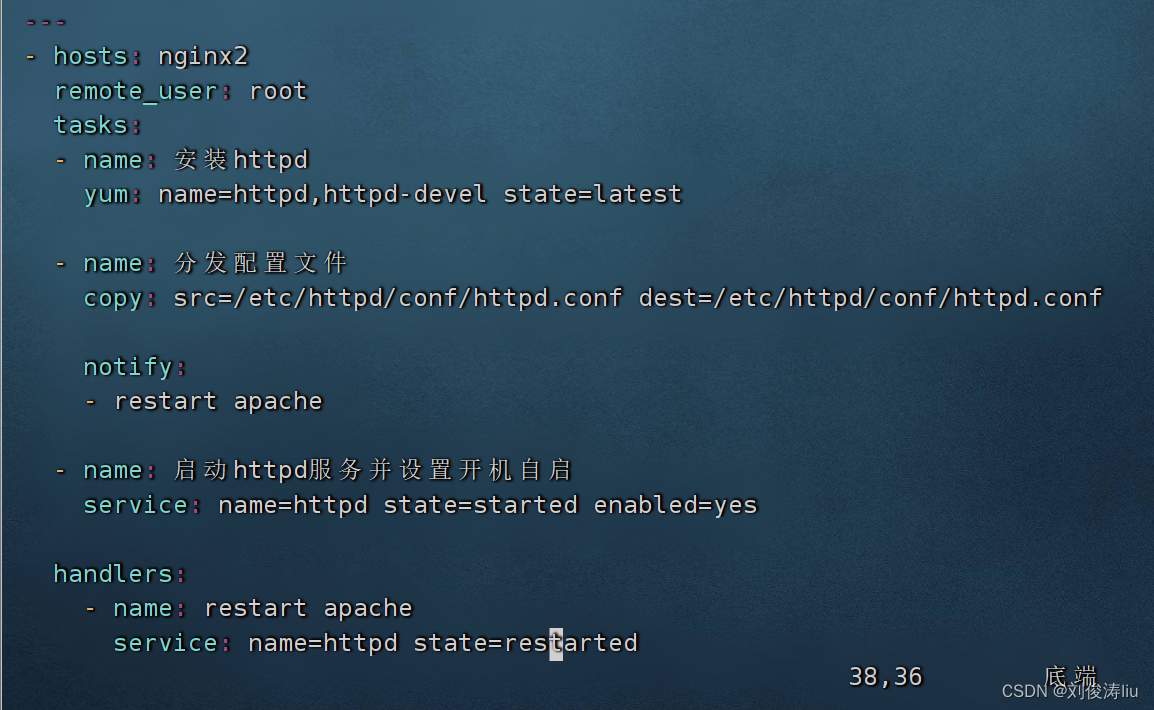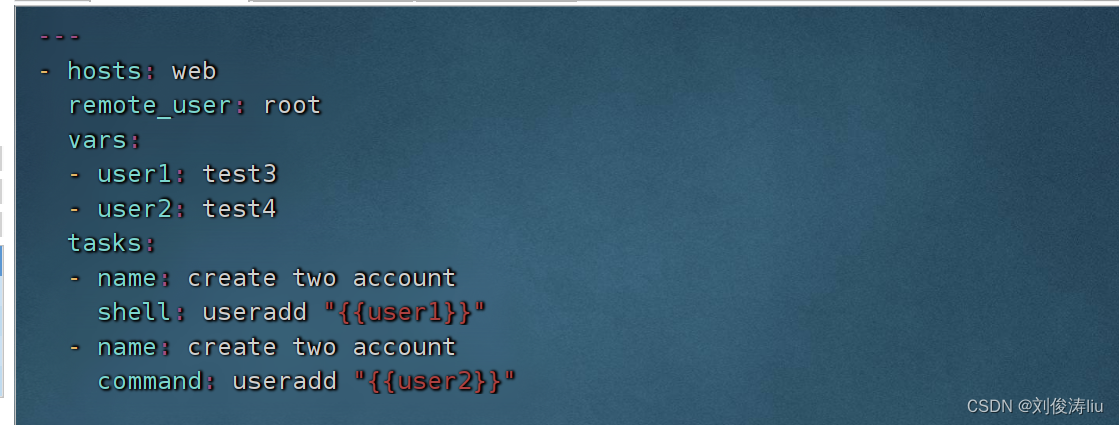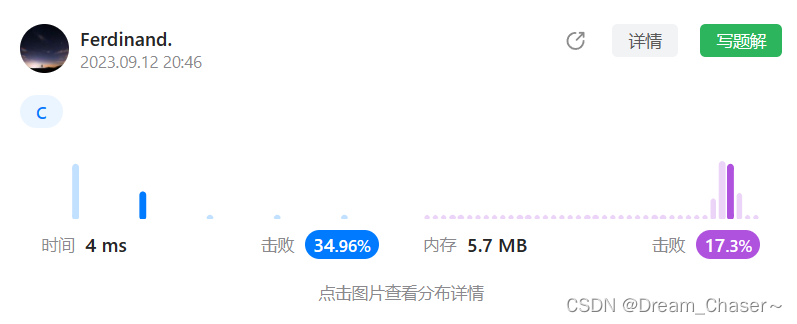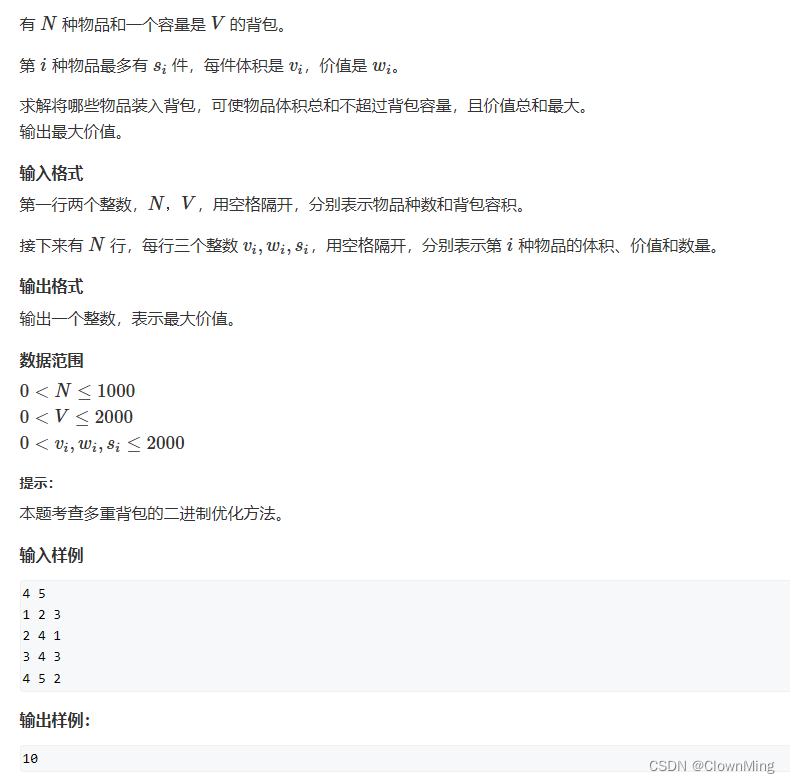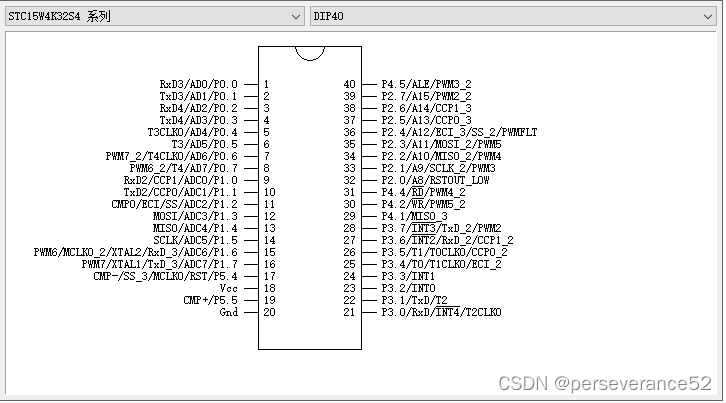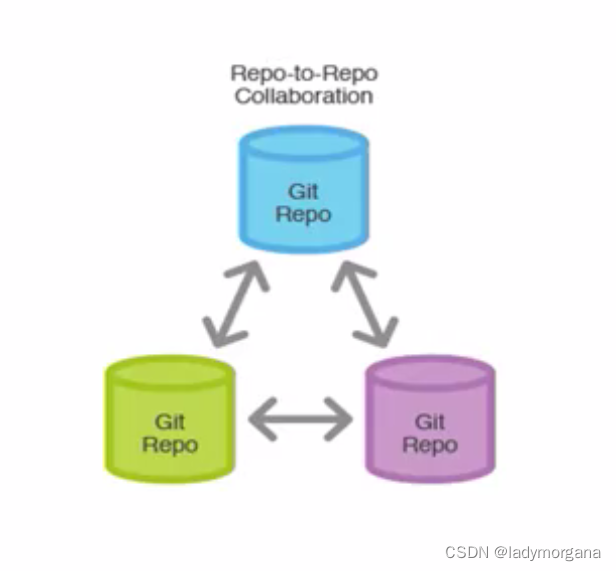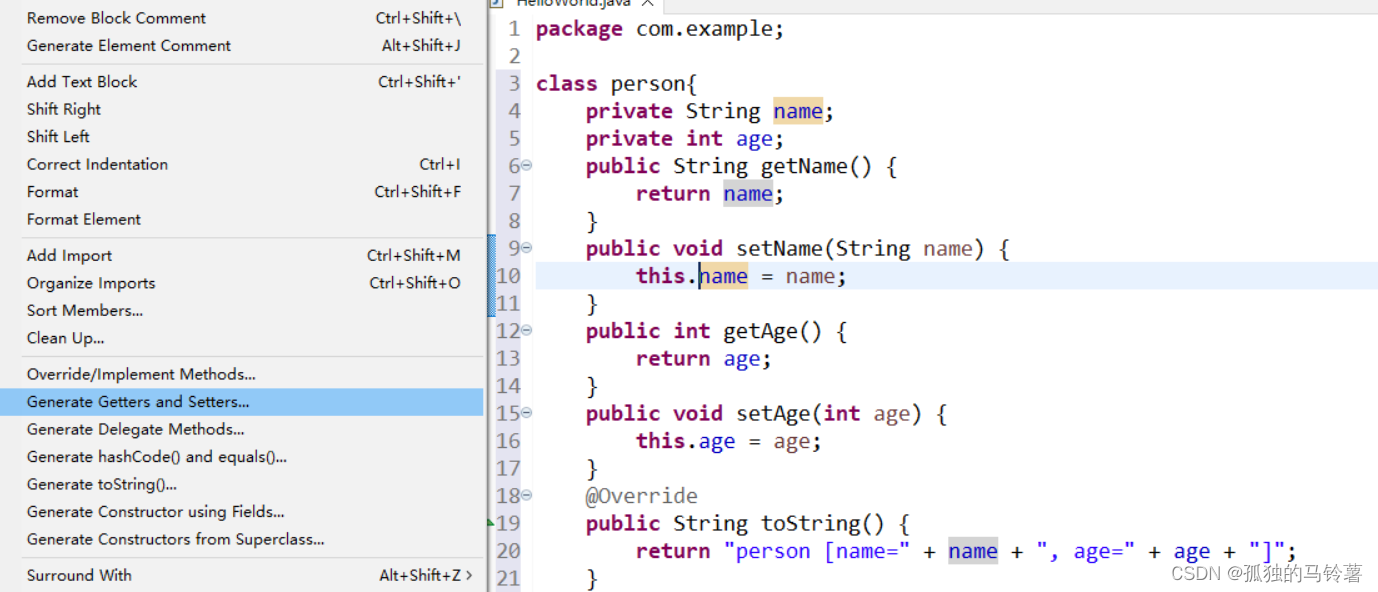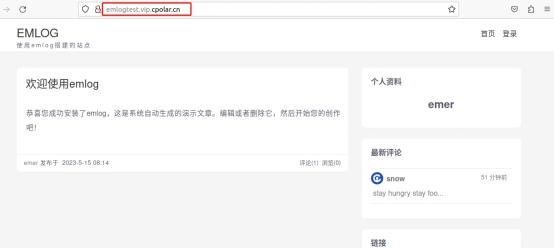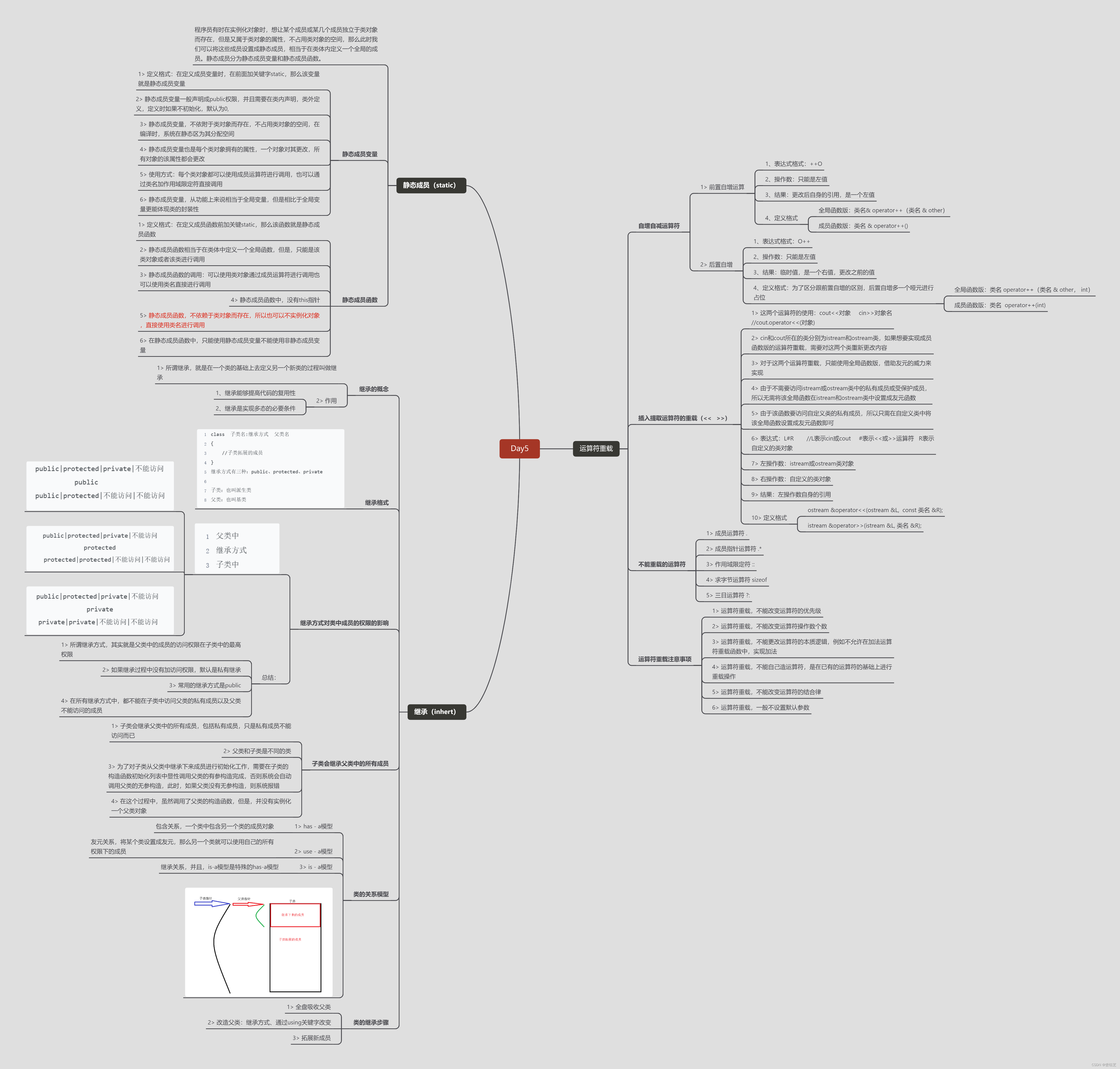目录
一、为什么要用自动化运维软件
二、自动化运维要注意的方面
1、管理机与被管理机之间的连接方式
2、服务器分组(主机清单)
3,、自动化运维的管理分类
三、常见的开源自动化运维软件
1、puppet
2、saltstack
3、ansible
四、自动化运维软件一般安装在哪
五、ansible主机清单
六、ansible模块
1、hostname
2、file
3、stat
4、copy
5、fetch
6、template
7、user
8、group
9、cron
10、yum_repositroy
11yum
12、service
13、script
14、command与shell
七、ansible编排
1、playbook
2、playbook相比于shell的优点
3、roles
八、实验
1、ansible搭建
2、静态IP和主机名及主机名互相绑定
3、ansible模块
3.1查看所有支持的模块
file模块(重点)
stat模块(了解)
copy模块(重点)
fetch模块
user模块
group模块
cron模块
yum_repository模块
yum模块(重点)
service模块(重点)
script模块
command与shell模块
九、playbook
1、YAML格式
2、playbook实例
4、Playbook常见语法
案例: playbook编排vsftpd
5、roles(难点)
6、通过roles实现lamp
Ansible是一种基于开源的自动化运维工具,可以帮助简化IT基础设施管理和应用程序的配置、部署和管理。它具有以下特点和优势:
简单易用:Ansible使用简单的YAML语法来定义配置和任务,无需编写复杂的脚本或程序。它易于理解和上手,使得自动化运维变得简单而直观。
基于SSH协议:Ansible使用SSH协议来与远程主机进行通信,无需在远程主机上安装任何额外的代理程序。这使得Ansible在安全性和兼容性方面有很好的表现,可以管理各种类型的主机和设备。
一、为什么要用自动化运维软件
因为服务器特别多的情况下,我们需要比shell更高效的管理工具
二、自动化运维要注意的方面
1、管理机与被管理机之间的连接方式
2、服务器分组(主机清单)
3,、自动化运维的管理分类
文件目录管理
用户与组管理
软件安装与卸载
服务启停与开机自启动
三、常见的开源自动化运维软件
1、puppet
基于ruby开发
2、saltstack
安装方便,需要维护管理机与被管理机的连接,走的zeromq协议。
优点: 管理机器多,速度快, 效率高
基于python开发
3、ansible
安装与连接方便,直接走ssh协议。
缺点: 管理机器特别多,效率较低
基于python开发
四、自动化运维软件一般安装在哪
一般安装在跳板机(堡垒机)整合使用
五、ansible主机清单
目的: 对管理的多台服务器进行分组
六、ansible模块
1、hostname
2、file
创建目录,普通文件,软硬链接
修改文件属性
删除文件
3、stat
4、copy
从本地把文件拷贝到远程机器并覆盖
应用: 主要用于统一修改配置文件
5、fetch
6、template
7、user
8、group
9、cron
10、yum_repositroy
11yum
安装与卸载rpm包
12、service
启停服务与开机是否自启动
13、script
远程执行本地脚本
14、command与shell
远程执行命令
七、ansible编排
1、playbook
使用YAML格式
2、playbook相比于shell的优点
幂等性
步骤与错误可视化
跨平台(因为基于python)
3、roles
类似开发语言的函数,将代码与功能封装,方便复用
八、实验
1、ansible搭建
实验准备:三台机器,一台管理两台被管理

2、静态IP和主机名及主机名互相绑定
hostnamectl set-hostname hd1
vim /etc/hosts
cat /etc/hosts
#hd2和hd3 同上类似操作 关闭防火墙, selinux和时间同步
关闭防火墙, selinux和时间同步
yum -y install epel-release
yum -y install ntp
systemctl stop firewalld
systemctl restart ntpd
systemctl enable ntpd
#监控机安装ansible
yum install ansible
ansible --version

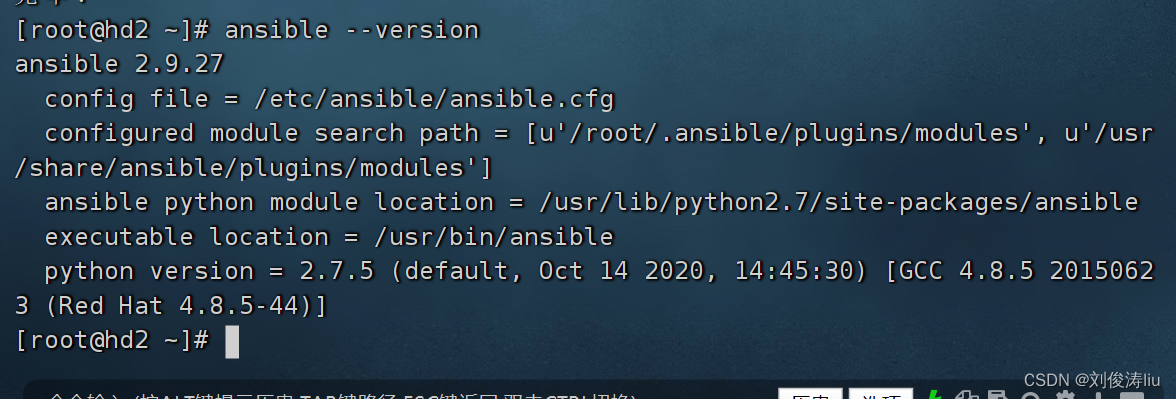
第2步: 实现master对agent的免密登录,只在master上做。(如果这一步不做,则在后面操作agent时都要加-k参数传密码;或者在主机清单里传密码)
ssh-keygen
ssh-copy-id -i 192.168.28.6
ssh-copy-id -i 192.168.28.7
第3步:在master上定义主机组,并测试连接性
vim /etc/ansible/hosts
ansible -m ping webserver
ansible -m ping all


服务器分组
ansible通过一个主机清单功能来实现服务器分组。
Ansible的默认主机清单配置文件为/etc/ansible/hosts.
示例:
[nginx] 组名
apache[1:10].aaa.com 表示apache1.aaa.com到apache10.aaa.com这10台机器
nginx[a:z].aaa.com 表示nginxa.aaa.com到nginxz.aaa.com共26台机器
10.1.1.[11:15] 表示10.1.1.11到10.1.1.15这5台机器
vim /etc/ansible/hosts
ansible -m ping webserver

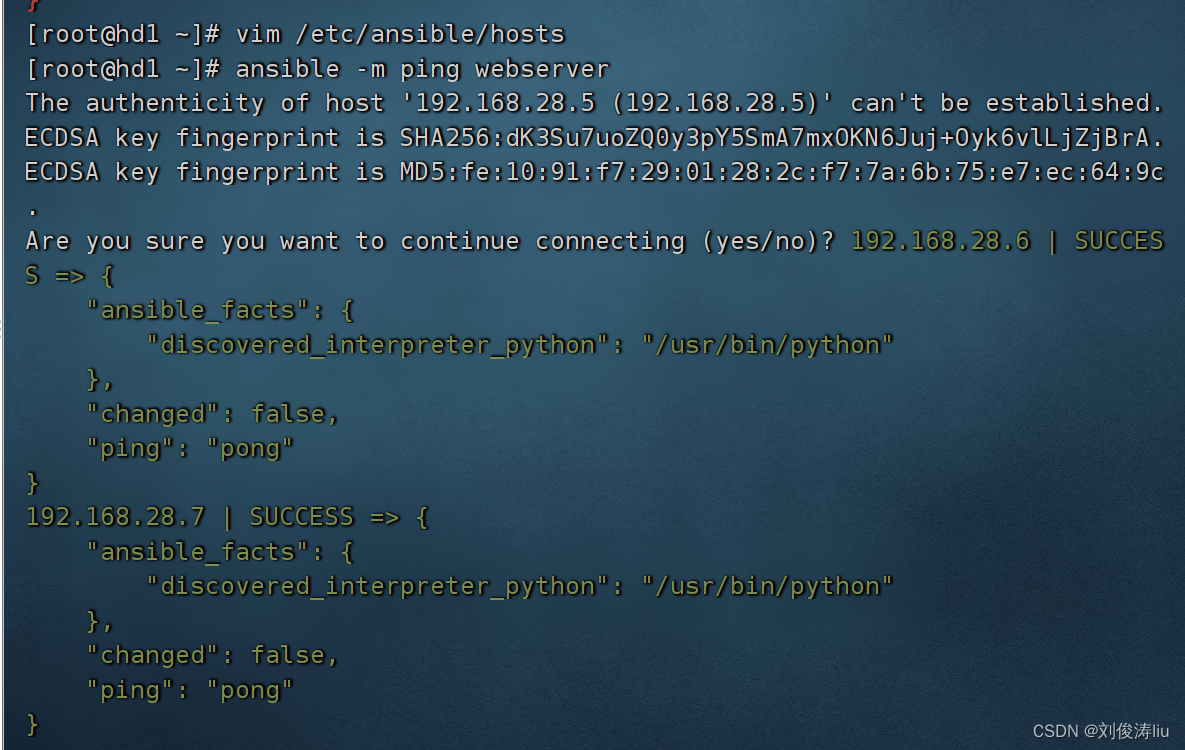
示例:
[nginx]
10.1.1.13:2222 表示10.1.1.13这台,但ssh端口为2222
vim /etc/ssh/sshd_config
systemctl restart sshd
netstat -anptu |grep :2222


这是在被管理机2上面的操作

回管理机
vim /etc/ansible/hosts
ansible -m ping nginx1


示例: 利用别名来分组
vim /etc/ansible/hosts
nginx1 ansible_ssh_host=192.168.28.6 ansible_ssh_port=2222
nginx2 ansible_ssh_host=192.168.28.7
[web]
nginx1
nginx2
ansible -m ping web
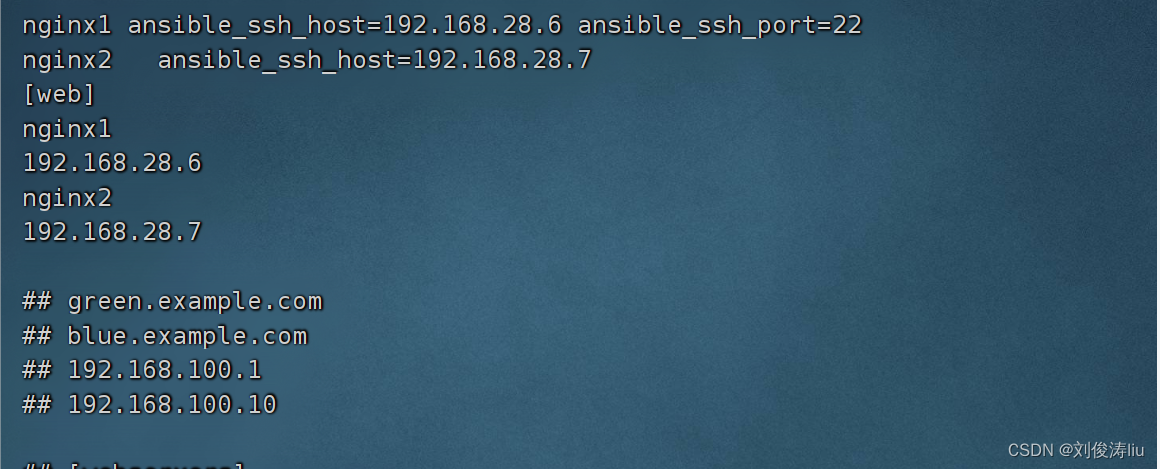

小结:
主机清单的作用: 服务器分组。
主机清单的常见功能:
可以通过IP范围来分, 主机名名字的范围来分
如果ssh端口不是22的,可以传入新的端口。
没有做免密登录,可以传密码。
不论你用哪种环境(免密或不免密,端口是否22), 请最终将两台被管理机器加入到group1组即可
3、ansible模块
ansible是基于模块工作的,本身没有批量部署的能力。真正具有批量部署的是ansible所运行的模块,ansible只是提供一种框架。
ansible支持的模块非常的多,我们并不需要把每个模块都记住,而只需要熟悉一些常见的模块,其它的模块在需要用到时再查询即可。
3.1查看所有支持的模块
ansible-doc -l 
如果要查看ping模块的用法,使用下面命令(其它模块以此类推)
ansible-doc ping
hostname模块
hostname模块用于修改主机名(注意: 它不能修改/etc/hosts文件)
将其中一远程机器主机名修改为agent1.cluster.com
master# ansible 192.168.28.6 -m hostname -a 'name=agent1.cluster.com'
基本格式为: ansible 操作的机器名或组名 -m 模块名 -a "参数1=值1 参数2=值2" argment
file模块(重点)
file模块用于对文件相关的操作(创建, 删除, 软硬链接等)
创建一个目录 、
ansible web -m file -a "path=/test state=directory"
创建一个文件
ansible nginx1 -m file -a "path=/test/111 state=touch"
去nginx下查看
递归修改owner,group,mode
ansible nginx1 -m file -a 'path=/test recurse=yes owner=bin group=daemon mode=1777'
这是一个使用Ansible工具在组名为nginx的主机上执行的命令,以递归方式创建一个名为/test的目录,并将其所有权设置为bin用户、daemon组,并设置其访问权限为1777
删除目录 absent 缺席的(连同目录里的所有文件)
ansible nginx1 -m file -a 'path=/test state=absent'
创建文件并指定owner,group,mode等
ansible nginx1 -m file -a "path=/tmp/111 state=touch owner=bin group=daemon mode=1777"
删除文件
ansible nginx1 -m file -a "path=/tmp/111 state=absent"
创建软链接文件
ansible nginx1 -m file -a 'src=/etc/fstab path=/tmp/fstab state=link'
创建硬链接文件
ansible nginx1 -m file -a 'src=/etc/fstab path=/tmp/fstab2 state=hard'
stat模块(了解)
stat模块类似linux的stat命令,用于获取文件的状态信息。
ansible nginx1 -m stat -a 'path=/etc/fstab'
copy模块(重点)
copy模块用于对文件的远程拷贝操作(如把本地的文件拷贝到远程的机器上)
在master上准备一个文件,拷贝此文件到web的所有机器上
echo master >/tmp/222
cat /tmp/222
ansible web -m copy -a 'src=/tmp/222 dest=/root/333'


使用content参数直接往远程文件里写内容(会覆盖原内容)
注意:ansible中-a后面的参数里也有引号时,记得要单引双引交叉使用,如果都为双引会出现问题
ansible web -m copy -a 'content="server\n" dest=/root/333'
去nginx1和nginx2上看
cat 333
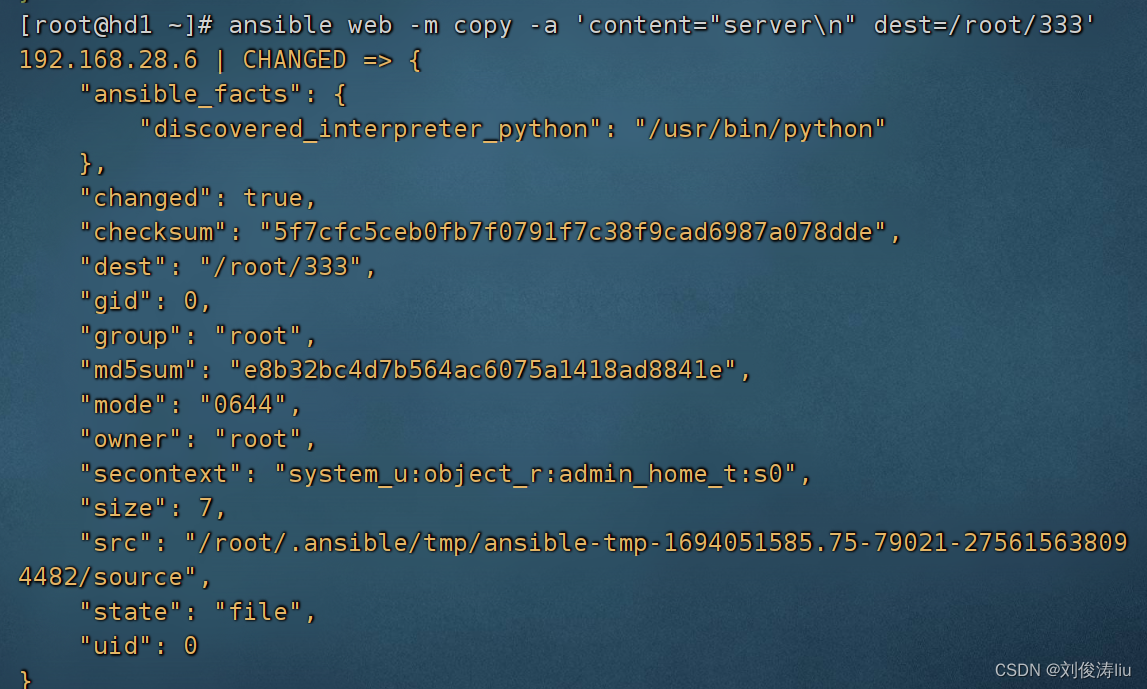

使用force参数控制是否强制覆盖
如果目标文件已经存在,则不覆盖
ansible web -m copy -a 'src=/tmp/222 dest=/tmp/333 force=no'
ansible web -m copy -a 'src=/tmp/222 dest=/tmp/333 force=no'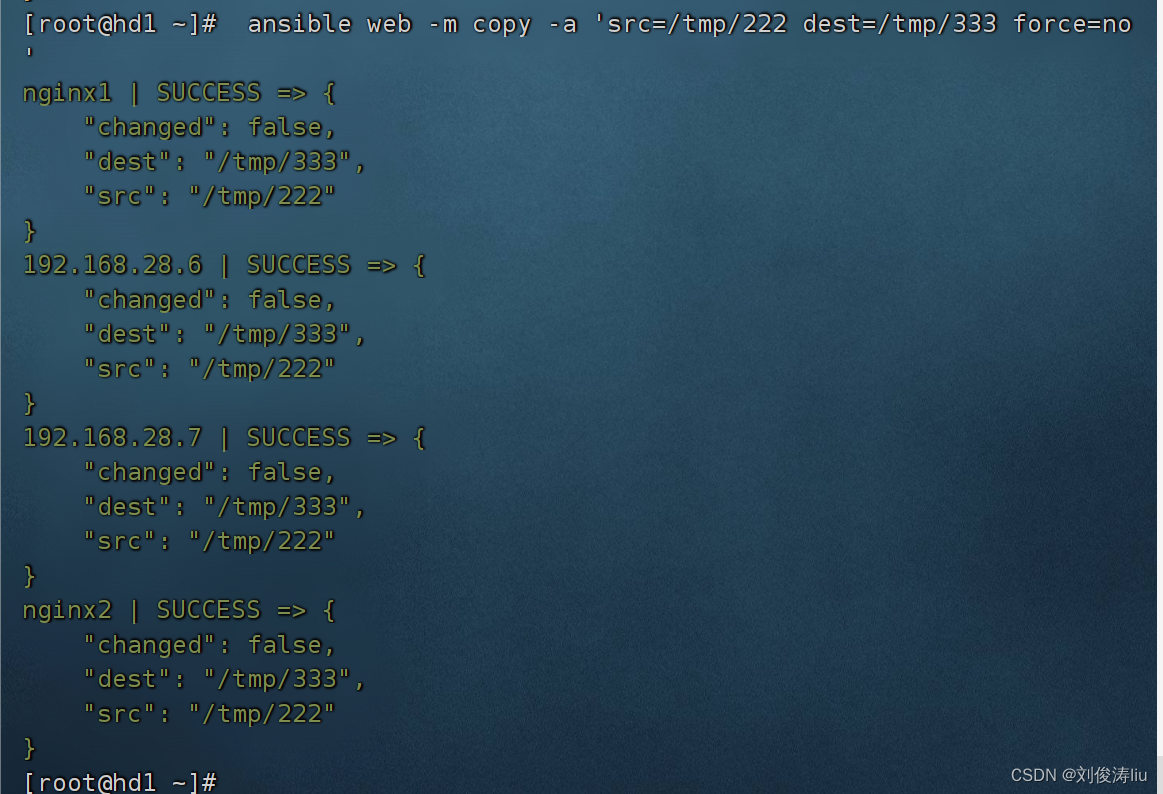
如果目标文件已经存在,则会强制覆盖
ansible web -m copy -a 'src=/tmp/222 dest=/tmp/333 force=yes'
ansible web -m copy -a 'src=/tmp/222 dest=/tmp/333 force=yes'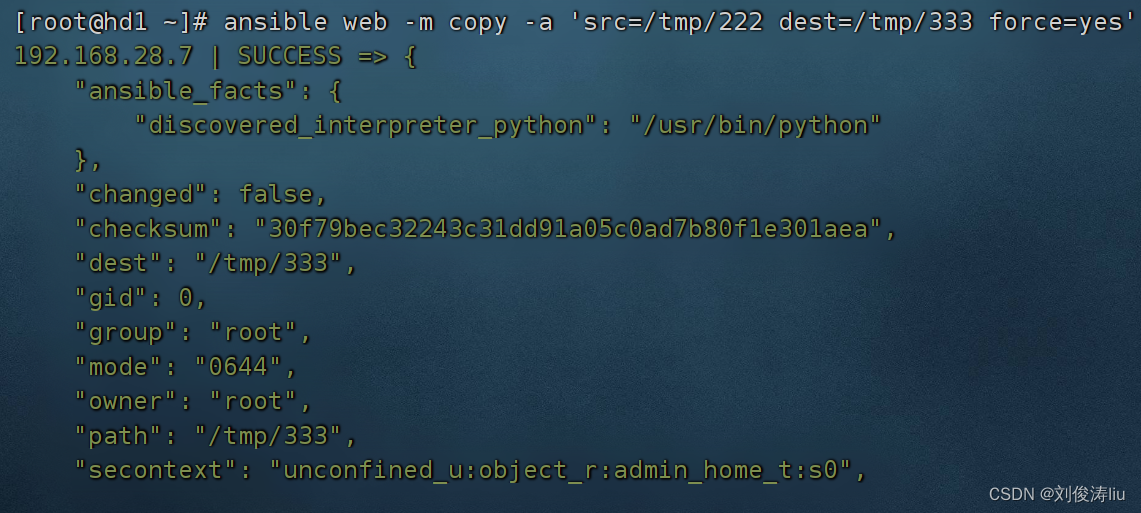
使用backup参数控制是否备份文件
backup=yes表示如果拷贝的文件内容与原内容不一样,则会备份一份
web的机器上会将/tmp/333备份一份(备份文件命名加上时间),再远程拷贝新的文件为/tmp/333
ansible web -m copy -a 'src=/etc/fstab dest=/tmp/333 backup=yes owner=daemon group=daemon mode=1777'


copy模块拷贝时要注意拷贝目录后面是否带"/"符号
/etc/yum.repos.d后面不带/符号,则表示把/etc/yum.repos.d整个目录拷贝到/tmp/目录下
ansible nginx1 -m copy -a 'src=/etc/yum.repos.d dest=/tmp/'
/etc/yum.repos.d/后面带/符号,则表示把/etc/yum.repos.d/目录里的所有文件拷贝到/tmp/目录下
ansible nginx1 -m copy -a 'src=/etc/yum.repos.d/ dest=/tmp/'

练习: 在master上配置好所有的yum源,然后拷贝到group1的远程机器上(要求目录内的内容完全一致)
删除yum.repo.d
ansible web -m file -a "path=/etc/yum.repos.d/ state=absent"
添加yum.repo.d
ansible web -m copy -a "src=/etc/yum.repos.d dest=/etc/"
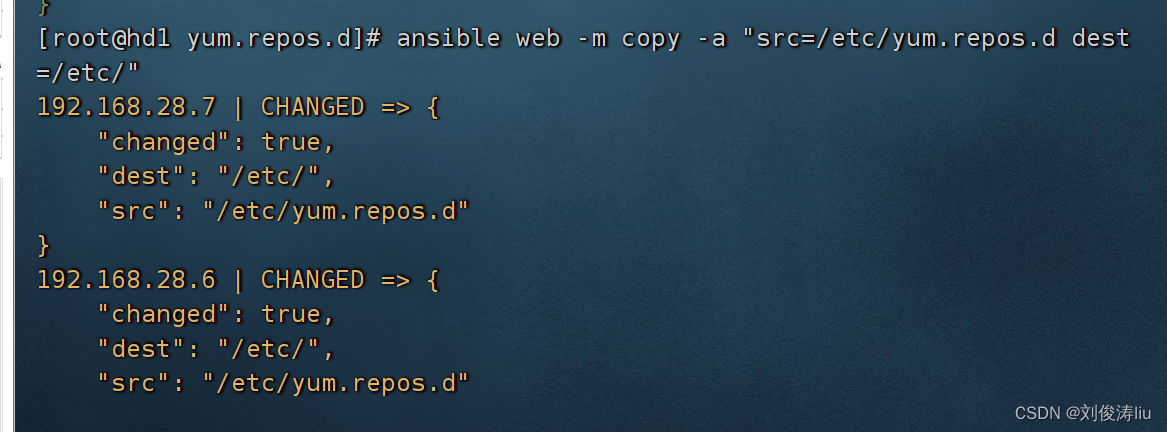
fetch模块
fetch模块与copy模块类似,但作用相反。用于把远程机器的文件拷贝到本地。
第1步: 在两台被管理机上分别创建一个同名文件(但内容不同)
agent1# echo agent1 > /tmp/1.txt
agent2# echo agent2 > /tmp/1.txt
第2步: 从master上fecth文件(因为group1里有2台机器,为了避免同名文件文件冲突,它使用了不同的目录)
ansible web -m fetch -a 'src=/tmp/1.txt dest=/tmp/'

第3步: 先删除上面fetch过来的, 然后尝试只fetch其中一台机器的,也会使用名称来做子目录区分
rm /tmp/192.168.28.* -rf
ansible 192.168.28.6 -m fetch -a 'src=/tmp/1.txt dest=/tmp/'

注意: fetch模块不能从远程拷贝目录到本地
user模块
user模块用于管理用户账号和用户属性。
创建aaa用户,默认为普通用户,创建家目录
ansible web -m user -a 'name=aaa state=present'
客户机
cat /etc/passwd |grep aaa


创建bbb系统用户,并且登录shell环境为/sbin/nologin
ansible web -m user -a 'name=bbb state=present system=yes shell="/sbin/nologin"'
cat /etc/passwd |grep bbb


创建ccc用户, 使用uid参数指定uid, 使用password参数传密码
echo 123456 | openssl passwd -1 -stdin
下一句命令注意一下格式,密码要用双引号引起来,单引号的话验证时会密码不正确
ansible web -m user -a 'name=ccc uid=2000 state=present password="$1$WDVnVIw9$eSYf4wXr3YUDnsoQA6OaP1"'



创建一个普通用户叫hadoop,并产生空密码 密钥对
ansible nginx1 -m user -a 'name=hadoop generate_ssh_key=yes'


删除aaa用户,但家目录默认没有删除
ansible nginx1 -m user -a 'name=aaa state=absent'
cd /home/
ls

删除bbb用户,使用remove=yes参数让其删除用户的同时也删除家目录
ansible nginx1 -m user -a 'name=bbb state=absent remove=yes'
ls

group模块
group模块用于管理用户组和用户组属性。
创建组
ansible web -m group -a "name=group gid=3000 state=present"


除组(如果有用户的gid为此组,则删除不了)
ansible web -m group -a "name=group state=absent"
cron模块
cron模块用于管理周期性时间任务
创建一个cron任务,不指定user的话,默认就是root(因为我这里是用root操作的)。 如果minute,hour,day,month,week不指定的话,默认都为*
这是每两分钟穿件一个文件
ansible web -m cron -a "name='test cron1' user=root job='touch/opt/111 ' minute=*/2"
每小时的30分钟创建一次、
ansible web -m cron -a "name='test cron2' user=root job='touch/opt/222 ' minute=30"
ansible:Ansible命令行工具。
web:在你的Ansible inventory文件中定义的主机组名。这指定了命令将在哪些主机上运行。
-m cron:要使用的Ansible模块。在这里,使用的是"cron"模块,该模块允许您管理cron定时任务。
-a "name='test cron2' user=root job='touch /opt/222' minute=30 hour=*/2":这是使用cron模块的参数。它指定了要创建的定时任务的名称("test cron2"),执行任务的用户(root),要执行的命令(touch /opt/222),以及任务的时间表(每小时的30分钟执行一次)。
因此,这个命令会在名为"web"的主机上配置一个名为"test cron2"的定时任务,以root用户的身份,在每两个小时的30分钟执行一次"touch /opt/222"命令。
ansible web -m cron -a "name='test cron2' user=root job='touch/opt/222 ' minute=30 hour=*/2"
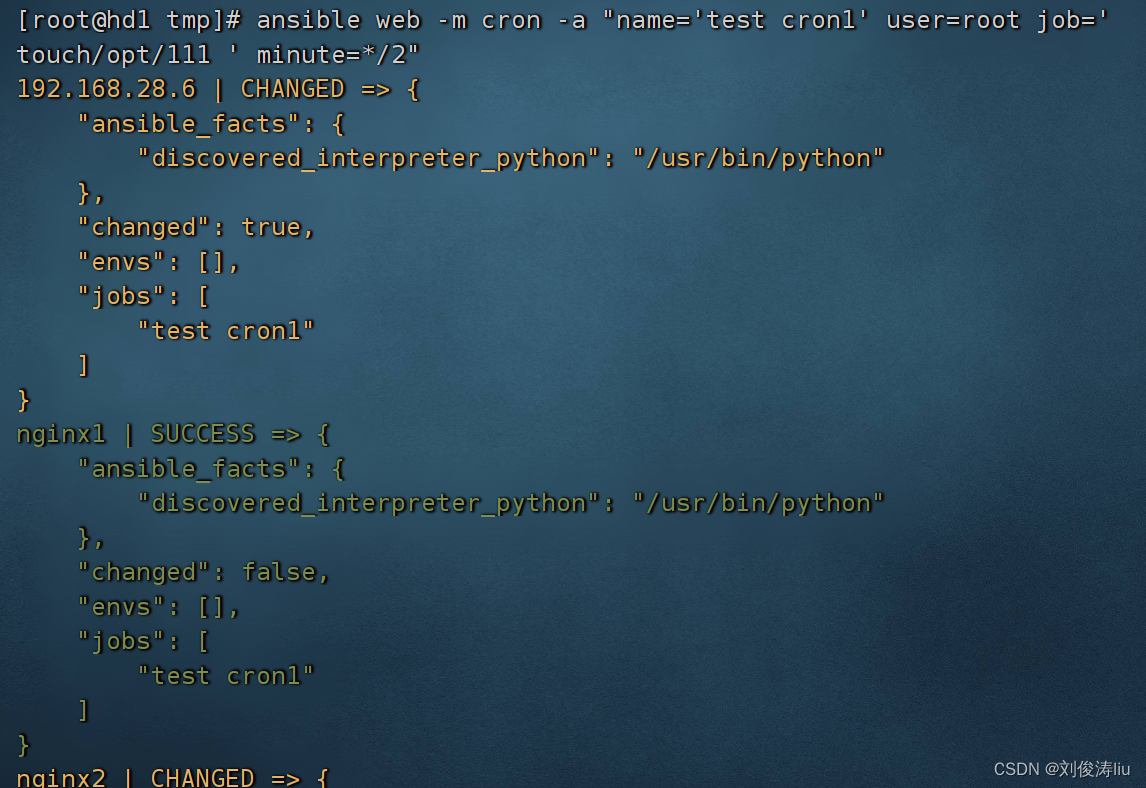


yum_repository模块
yum_repository模块用于配置yum仓库。
增加一个/etc/yum.repos.d/local.repo配置文件
ansible nginx1 -m yum_repository -a "name=local description=localyum baseurl=fole:///mnt/ enabled=yes gpgcheck=no"


注意:此模块只帮助配置yum仓库,但如果仓库里没有软件包,安装一样会失败。所以可以手动去挂载光驱到/mnt目录
删除/etc/yum.repos.d/local.repo配置文件
ansible nginx1 -m yum_repository -a "name=local state=absent"

yum模块(重点)
yum模块用于使用yum命令来实现软件包的安装与卸载。
用yum安装一个软件(前提:group1的机器上的yum配置都已经OK)
使用yum安装httpd,httpd-devel软件,state=latest表示安装最新版本
ansible nginx1 -m yum -a "name=httpd,httpd-devel state=present"


使用yum卸载httpd,httpd-devel软件
ansible nginx1 -m yum -a "name=httpd,httpd-devel state=absent"

、使用yum安装一个软件(前提:group1的机器上的yum配置都已经OK)
ansible nginx1 -m yum -a "name=vsftpd state=present"

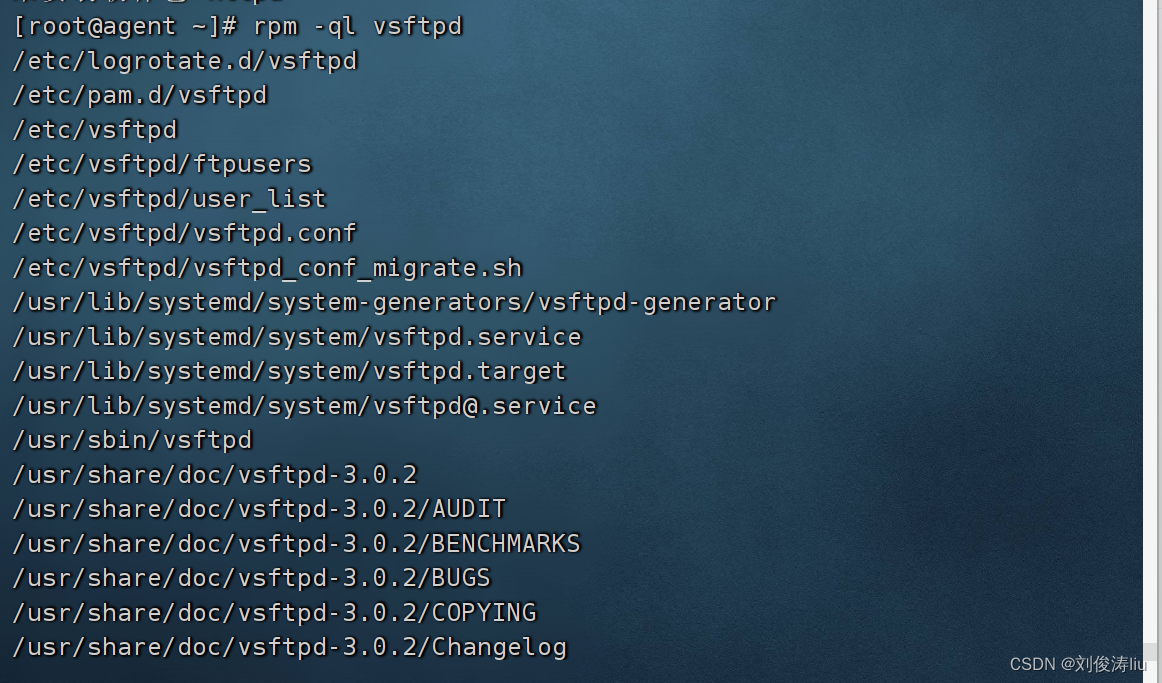
service模块(重点)
service模块用于控制服务的启动,关闭,开机自启动等。
启动vsftpd服务,并设为开机自动启动
ansible nginx1 -m service -a "name=vsftpd state=started enabled=no"
关闭vsftpd服务,并设为开机不自动启动
ansible nginx1 -m service -a "name=vsftpd state=stopped enabled=false"

script模块
script模块用于在远程机器上执行本地脚本。
在master上准备一个脚本
vim 1.sh
#!/bin/bash
mkdir /opt/111
touch /opy/hahah{1..10}在nginx1的远程机器里都执行master上的1.sh脚本(此脚本不用给执行权限)
ansible group1 -m script -a '/1.sh'ansible nginx1 -m script -a "/root/1.sh"
扩展: 使用shell脚本实现在nginx1的被管理机里的mariadb里创建一个abc库
#!/bin/bash
yum install mariadb-server -y &> /dev/null
systemctl start mariadb
systemctl enable mariadbmysql << EOF
create database abc;
quit
EOF把上面的脚本使用script模块在web被管理机里执行即可
command与shell模块
两个模块都是用于执行linux命令的,这对于命令熟悉的工程师来说,用起来非常high。
shell模块与command模块差不多(command模块不能执行一些类似$HOME,>,<,|等符号,但shell可以)
ansible -m command nginx2 -a "useradd user2"
ansible -m command nginx2 -a "id user2"

ansible -m command nginx2 -a "cat /etc/passwd |wc -l"
ansible -m shell nginx2 -a "cat /etc/passwd |wc -l"

注意: shell模块并不是百分之百任何命令都可以,比如vim或ll别名就不可以。不建议大家去记忆哪些命令不可以,大家只要养成任何在生产环境里的命令都要先在测试环境里测试一下的习惯就好。
九、playbook
playbook(剧本): 是ansible用于配置,部署,和管理被控节点的剧本。用于ansible操作的编排。
使用的格式为yaml格式(saltstack,elk,docker,docker-compose,kubernetes等也都会用到yaml格式)
1、YAML格式
以.yaml或.yml结尾
文件的第一行以 "---"开始,表明YMAL文件的开始(可选的)
以#号开头为注释
列表中的所有成员都开始于相同的缩进级别, 并且使用一个 "- " 作为开头(一个横杠和一个空格)
一个字典是由一个简单的 键: 值 的形式组成(这个冒号后面必须是一个空格)
==注意: 写这种文件不要使用tab键,都使用空格==
下面看一个官方的示例感受一下
---
# 一位职工记录
name: Example Developer
job: Developer
skill: Elite
employed: True
foods:
- Apple
- Orange
- Strawberry
- Mango
languages:
ruby: Elite
python: Elite
dotnet: Lame
2、playbook实例
先直接来看一个实例
第1步: 创建一个存放playbook的目录(路径自定义)
master# mkdir /etc/ansible/playbook第2步: 准备httpd配置文件,并修改成你想要的配置
master# yum install httpd -y
按需要修改你想要的配置(为了测试可以随意改动标记一下)
master# vim /etc/httpd/conf/httpd.conf
第3步: 写一个playbook文件(后缀为.yml或.yaml)
# vim /etc/ansible/playbook/example.yaml
---
- hosts: nginx2
remote_user: root
tasks:
- name: ensure apache is at the latest version
yum: name=httpd,httpd-devel state=latest
- name: write the apache config file
copy: src=/etc/httpd/conf/httpd.conf dest=/etc/httpd/conf/httpd.conf
notify:
- restart apache
- name: ensure apache is running (and enable it at boot)
service: name=httpd state=started enabled=yes
handlers:
- name: restart apache
service: name=httpd state=restarted
第4步: 执行写好的palybook
会显示出执行的过程,并且执行的每一步都有ok,changed,failed等标识
执行如果有错误(failed)会回滚,解决问题后,直接再执行这条命令即可,并会把failed改为changed(幂等性)
ansible-playbook /etc/ansible/playbook/example.yaml
端口修改完成

4、Playbook常见语法
hosts: 用于指定要执行任务的主机,其可以是一个或多个由冒号分隔主机组.
remote_user: 用于指定远程主机上的执行任务的用户.
- hosts: nginx2
remote_user: root
tasks: 任务列表, 按顺序执行任务.
如果一个host执行task失败, 整个tasks都会回滚, 修正playbook 中的错误, 然后重新执行即可.
tasks:
- name: ensure apache is at the latest version
yum: name=httpd,httpd-devel state=latest
- name: write the apache config file
copy: src=/etc/httpd/conf/httpd.conf dest=/etc/httpd/conf/httpd.conf
handlers: 类似task,但需要使用notify通知调用。
不管有多少个通知者进行了notify,等到play中的所有task执行完成之后,handlers也只会被执行一次.
handlers最佳的应用场景是用来重启服务,或者触发系统重启操作.除此以外很少用到了.
notify:
- restart apache
- name: ensure apache is running (and enable it at boot)
service: name=httpd state=started enabled=yes
handlers:
- name: restart apache
service: name=httpd state=restarted
variables: 变量
定义变量可以被多次方便调用
vim /etc/ansible/playbook/example2.yaml
---
- hosts: web
remote_user: root
vars:
- user1: test3
- user2: test4
tasks:
- name: create two account
shell: useradd "{{user1}}"
- name: create two account
command: useradd "{{user2}}"ansible-playbook /etc/ansible/playbook/example2.yaml
案例: playbook编排vsftpd
写一个playbook实现
配置yum
安装vsftpd包
修改配置文件(要求拒绝匿名用户登录)
启动服务并实现vsftpd服务开机自动启动
本机安装vsftpd开始写脚本

---
- hosts: nginx1
remote_user: root
tasks:
- name: rm yum repository
file: path=/etc/yum.repos.d/ state=absent- name: 同步master上的yum源到group1
copy: src=/etc/yum.repos.d dest=/etc/- name: ensure vsftpd is at the latest version
yum: name=vsftpd state=latest- name: write the apache config file
copy: src=/etc/vsftpd/vsftpd.conf dest=/etc/vsftpd/vsftpd.confnotify:
- restart vsftpd- name: ensure vsftpd is running (and enable it at boot)
service: name=vsftpd state=started enabled=yeshandlers:
- name: restart vsftpd
**playbook编排多个hosts任务**
--- # ---代表开始(可选项,不写也可以)
- hosts: nginx1
remote_user: root
tasks:
- name: 创建/test1/目录
file: path=/test1/ state=directory
# 这里不能用---分隔,会报语法错误(后面课程玩k8s编排也写YAML文件,是可以用--->来分隔段落的)
- hosts: nginx2
remote_user: root
tasks:
- name: 创建/test2/目录
file: path=/test2/ state=directory
... # ...代表结束(可选项,不写也可以)
ansible-playbook /etc/ansible/playbook/2.hosts
5、roles(难点)
roles介绍
roles(角色): 就是通过分别将variables, tasks及handlers等放置于单独的目录中,并可以便捷地调用它们的一种机制。
假设我们要写一个playbook来安装管理lamp环境,那么这个playbook就会写很长。所以我们希望把这个很大的文件分成多个功能拆分, 分成apache管理,php管理,mysql管理,然后在需要使用的时候直接调用就可以了,以免重复写。就类似编程里的模块化的概念,以达到代码复用的效果。
files:用来存放由copy模块或script模块调用的文件。
tasks:至少有一个main.yml文件,定义各tasks。
handlers:有一个main.yml文件,定义各handlers。
templates:用来存放jinjia2模板。
vars:有一个main.yml文件,定义变量。
meta:有一个main.yml文件,定义此角色的特殊设定及其依赖关系。
**注意:** 在每个角色的目录中分别创建files, tasks,handlers,templates,vars和meta目录,用不到的目录可以创建为空目录.
6、通过roles实现lamp
需定制三个角色: httpd,mysql,php
第1步: 创建roles目录及文件,并确认目录结构
nginx1 ansible_ssh_host=192.168.28.4 ansible_ssh_port=22
nginx2 ansible_ssh_host=192.168.28.5 ansible_ssh_port=22
[web]
nginx1
nginx2
master# cd /etc/ansible/roles/
master# mkdir -p {httpd,mysql,php}/{files,tasks,handlers,templates,vars,meta}
master# touch {httpd,mysql,php}/{tasks,handlers,vars,meta}/main.ymlmaster# yum install tree -y
master# tree /etc/ansible/roles/
/etc/ansible/roles/
├── httpd
│ ├── files
│ ├── handlers
│ │ └── main.yml
│ ├── meta
│ │ └── main.yml
│ ├── tasks
│ │ └── main.yml
│ ├── templates
│ └── vars
│ └── main.yml
├── mysql
│ ├── files
│ ├── handlers
│ │ └── main.yml
│ ├── meta
│ │ └── main.yml
│ ├── tasks
│ │ └── main.yml
│ ├── templates
│ └── vars
│ └── main.yml
└── php
├── files
├── handlers
│ └── main.yml
├── meta
│ └── main.yml
├── tasks
│ └── main.yml
├── templates
└── vars
└── main.yml
第2步: 准备httpd服务器的主页文件,php测试页和配置文件等
master# echo "test main page" > /etc/ansible/roles/httpd/files/index.html
master# echo -e "<?php\n\tphpinfo();\n?>" > /etc/ansible/roles/httpd/files/index.php
master# yum install httpd -y
按需求修改配置文件后,拷贝到httpd角色目录里的files子目录
master# vim /etc/httpd/conf/httpd.conf
master# cp /etc/httpd/conf/httpd.conf /etc/ansible/roles/httpd/files/
第3步: 编写httpd角色的main.yml文件

vim /etc/ansible/roles/httpd/tasks/main.yml
---
- name: 安装httpd
yum: name=httpd,httpd-devel state=present- name: 同步httpd配置文件
copy: src=/etc/ansible/roles/httpd/files/httpd.conf dest=/etc/httpd/conf/httpd.confnotify: restart httpd
- name: 同步主页文件
copy: src=/etc/ansible/roles/httpd/files/index.html dest=/var/www/html/index.html- name: 同步php测试页
copy: src=/etc/ansible/roles/httpd/files/index.php dest=/var/www/html/index.php- name: 启动httpd并开机自启动
service: name=httpd state=started enabled=yes
第4步: 编写httpd角色里的handler
[root@master tasks]# vim /etc/ansible/roles/httpd/handlers/main.yml
---
- name: restart httpd
service: name=httpd state=restarted
第5步: 编写mysql角色的main.yml文件
vim /etc/ansible/roles/mysql/tasks/main.yml
---
- name: 安装mysql
yum: name=mariadb,mariadb-server,mariadb-devel state=present- name: 启动mysql并开机自启动
service: name=mariadb state=started enabled=yes
第6步: 编写php角色的main.yml文件
master# vim /etc/ansible/roles/php/tasks/main.yml
---
- name: 安装php及依赖包
yum: name=php,php-gd,php-ldap,php-odbc,php-pear,php-xml,php-xmlrpc,php-mbstring,php-snmp,php-soap,curl,curl-devel,php-bcmath,php-mysql state=presentnotify: restart httpd
第7步:编写lamp的playbook文件调用前面定义好的三个角色
master执行
vim lamp.yaml
---
- hosts: nginx1
remote_user: root
roles:
- httpd
- mysql
- php
ansible-playbook /root/lamp.yaml


















